Top-to-tail eating: Recipes to use a whole pineapple or bunch of beetroot
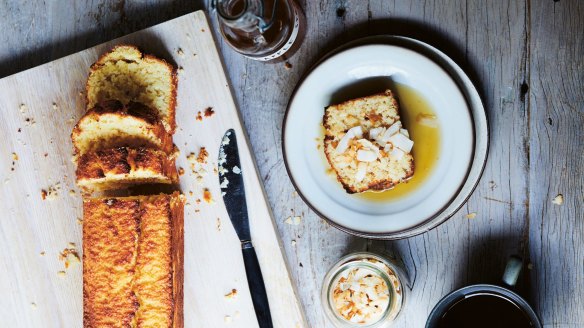
It's an unseasonably warm Tuesday when I get hold of Alex Elliott-Howery. She's in the kitchen at the Cornersmith Picklery in Marrickville, in Sydney's inner west, working her way through the 300 to 500 jars of pickles the team makes each week. She pauses to grab her headphones and a flurry of sounds – clanking jars, general fluttering, a pair of giggles and the word "coffee" – echo down the line.
"I am now being a pickler again, which I love," she says.
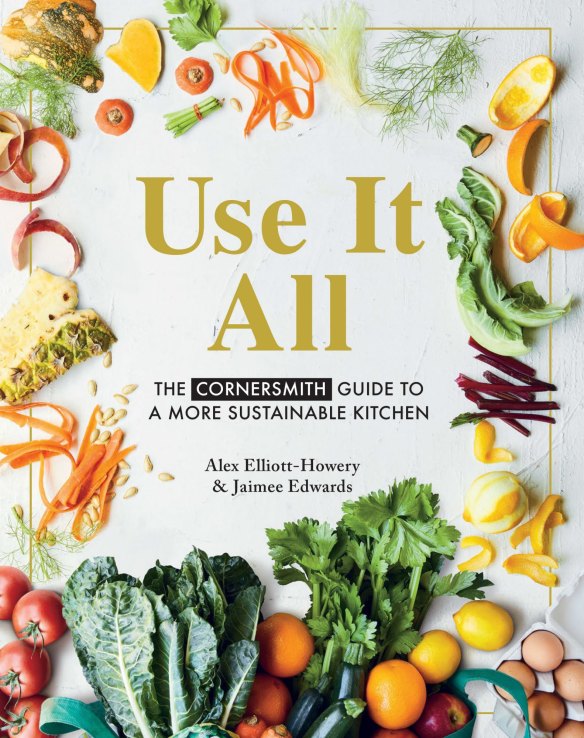
In these unusual times, Elliott-Howery is back in the kitchen, along with two colleagues, focusing less on admin and more on the making.
"I started this business because I love cooking and I love preserving things … so that has been one of the silver linings [amid COVID-19]. It brings me joy."
The "business" is many things: a cooking school, a cafe in Annandale, a picklery, an online store and cookbooks. Now there's Use It All, a much-needed "handbook", Elliott-Howery says, more than anything else. She wrote it with Cornersmith's head fermenter, Jaimee Edwards, a dear friend.
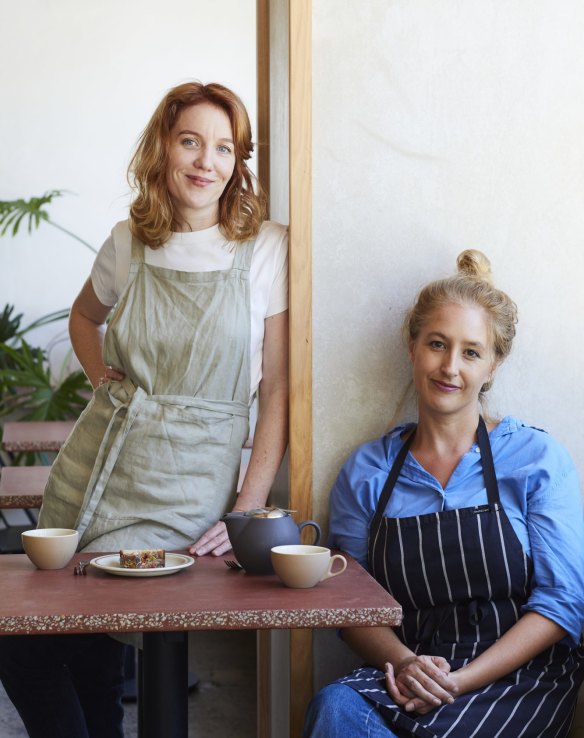
It's a response to "watching people in my kitchen space cooking and chucking things into the bin without thinking about it," she says.
"I watched everyone chop the leaves off the celery or the top of the fennels, and I was screaming, 'Don't throw it away!' … I don't know where this habit [of throwing things out] came from, but it's how we all learned to cook."
With four teenagers between them, Elliott-Howery and Edwards envisage the book being the perfect antidote to ill-informed cooking foundations, with advice on how to best use produce, minimise waste, optimise peels and offcuts, and wholly value food products.
"So many people leave home and don't quite have that knowledge," Elliott-Howery says. "Our teenagers roll their eyes constantly at us, but I hope it's sinking in somewhere."
The cookbook, Elliott-Howery's third, embraces the challenge, shopping basket by shopping basket, with the approach blossoming from a simple concept: buy local, buy less, and do more with it.
"You won't see a quince or a pomegranate. It's the stuff that's in people's fridges, all the time," she says. "We want to show people how to use up all those vegetables and fruit."
But make it delicious.
"I feel like 'use up' makes it sound like you force yourself to eat it. People tell me about these disgusting smoothies they make with, like, lettuce and a banana. [Each recipe] only made it into the book if we really loved it at the same time as it being a good environmental choice."
While one recipe advises fashioning potato skins (if you must peel them at all) into wine-friendly chips and another transforms sauteed leek tops into a garlicky green side, banana peels did not make the cut.
"We tried. Oh, we tried. It wasn't good."
Elliott-Howery hopes Use It All is a step towards a bigger cultural change, providing more awareness of how fragile and valuable the agriculture ecosystem is as well as a more considered approach to where our food comes from. She's thinking about how she can instil that from the ground up, with hopes of writing a program for high school and TAFE curricula.
"If people learn properly, if people everywhere start thinking about food and food waste, not just about getting food on the table – that's where we could see proper change," she says. "This book is the beginning of that conversation that's bigger for me and for Jaimee and for Cornersmith."
– Riley Wilson
Pineapple
Native to South America, the pineapple got its strange name because colonial Europeans had a habit of comparing something unfamiliar with something they knew from home, and thought that the pineapple resembled the pine cone.
The fruit of the pineapple is actually made up of 100-200 individual flowers fused together around a central stem. The diamond pattern on a mature pineapple is the remains of these flowers.
Pineapple is low in starch so it does not continue to develop its sugars after harvesting. For this reason, pineapple should be cut when fully ripe. A ripe pineapple will give a thud sound if you tap it and it shouldn't look too green.
Pineapples are very high in vitamin C and there is more than 100 per cent of your recommended daily intake in one cup. They are also extremely high in a mineral called manganese, which is essential for bone health. Plus, even conventionally grown pineapples use few pesticides or chemicals in their production. Do you really need any more reasons to cut up a pineapple after dinner and serve it for dessert?
Keep pineapple at room temperature with the skin and top on for about three days. Cut pineapple will keep in an airtight container in the fridge for a week.
Goes with …
Pineapple goes well with bananas and kiwifruit, mangoes and coconut. It is also perfect with spicier pairings of chilli, cinnamon, pepper and coriander. We love pineapple with all seafood. Whether pineapple should ever be seen on a pizza is a matter for your own household to discuss. In both our homes the kids have worn us down – we have surrendered.
Waste tip
Don't toss the pineapple skins – they're full of flavour and can be easily made into a delicious drink or syrup.
Pineapple hot sauce
We teach this hot sauce recipe in our chilli preserving workshops at Cornersmith. It's a great base recipe for making spicy sauces from excess fruit. We make this mostly with pineapples and green chillies, but peaches, plums, mangoes or green tomatoes work really well, too. If you are using pineapple, make sure you save the skins for the pineapple soda or pineapple skin syrup.
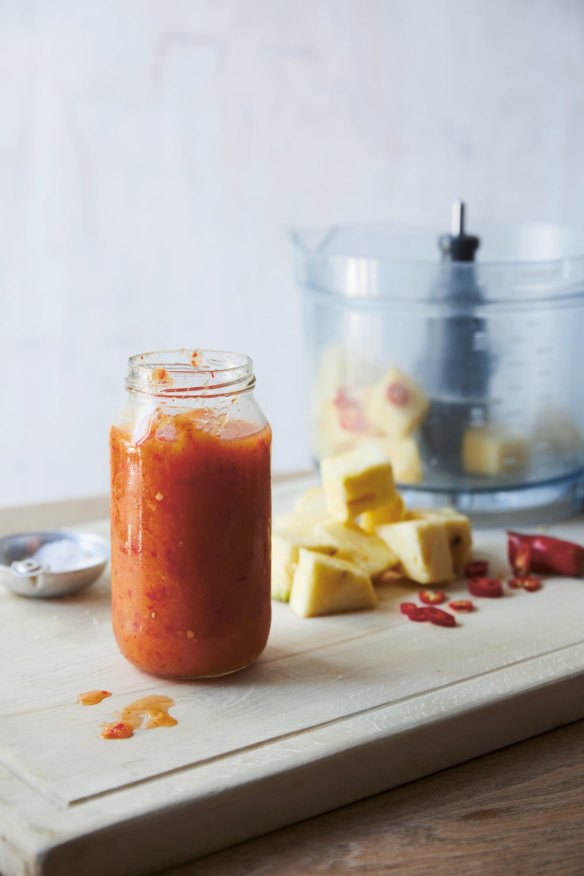
INGREDIENTS
- 50-150g (long green or red chillies (depending on how hot your chillies are), roughly chopped
- 35g ginger, grated
- 2 garlic cloves, grated
- zest and juice of 2 limes or 1 lemon
- 800g-1kg skinned pineapple, chopped into 3cm chunks
- 1 cup (250ml) apple cider vinegar
- 3 tbsp castor sugar
- 1 tbsp salt
METHOD
- Place the chilli, ginger, garlic and lime or lemon zest in the bowl of a food processor and blitz to a paste. With the motor running slowly, pour in the lime or lemon juice.
- Add half the chopped pineapple and blitz until smooth, then add the remaining pineapple and blend again to form a smooth paste. Pour the paste into a saucepan and stir through the vinegar, sugar and salt. Bring to a gentle simmer and cook for 15-20 minutes, until you have a thick sauce.
- Pour the sauce into sterilised bottles and keep in the fridge for up to 8 weeks. Alternatively, heat-process the bottled sauce for 15 minutes and store in a cool, dark place for up to 1 year. Once opened, store in the fridge and use within 4 months.
Makes 4 cups (1 litre)
Tip: You can also add coriander roots, shallots or spring onions when blending
Whole pineapple cake
This is a delicious morning or afternoon tea cake and a staple at the Cornersmith cafe. We love it because it uses the whole fruit and extracts as much flavour as possible from the pineapple's flesh, core and skin. You can also just use pineapple cores if you have an excess left over from another recipe – char them on a grill to intensify their flavour and sweetness before you puree them. Feel free to experiment with this recipe using oranges, lemons or other fruit purees.
INGREDIENTS
1 pineapple
- 150g (1½ cups) almond meal
- 250g (2¾ cups) desiccated coconut
- 1 tsp baking powder
- 6 eggs
- 250g castor sugar
- toasted coconut flakes, to serve
- natural or Greek yoghurt, to serve
METHOD
- Preheat the oven to 140C fan-forced (160C conventional) and line a 30cmloaf tin with baking paper.
- Cut the skin off the pineapple and set aside, then cut the flesh and core into small cubes and blitz them in a food processor until smooth. You'll need 400g of pineapple puree for the batter.
- Whisk together the almond meal, desiccated coconut and baking powder in a large bowl and set aside. In a stand mixer with the whisk attachment, whisk the eggs and sugar on medium speed until pale and fluffy (or you can do this in a large bowl with a hand whisk). Add the pineapple puree to the egg mixture and whisk for another minute. Slowly add the dry ingredients in batches, whisking well after each addition. Pour the mixture into the prepared tin and bake for 50-60 minutes, until golden brown and a skewer inserted into the centre of the cake comes out clean.
- Meanwhile use the pineapple skin to make pineapple skin syrup (see recipe below).
- Leave the cake to cool in the tin on a wire rack for 10 minutes before turning out. Serve straight away or keep in an airtight container in the fridge for up to 1 week. Serve warm or toasted with the pineapple skin syrup, toasted coconut and yoghurt.
Serves 8
PINEAPPLE SODA
This is based on the Mexican beverage tepache, a sweet and sour drink with an unexpected hit of heat. This is a simple ferment so don't be afraid to give it a go. The results are sweet, spicy and naturally fizzy. Enjoy ice cold.
Place the skins from ½ a pineapple, 55g (¼ cup) brown sugar, 1 cinnamon stick and 1 fresh jalapeno or hot red chilli in a clean 500ml jar and fill with water. Cover with muslin and secure with a rubber band. Stir 2-3 times a day over 2 days, during which time the sugars will convert to lactic acid.
Strain the soda into a jug and discard the solid ingredients. Wash out the jar and pour the strained soda back in, but this time secure with the lid to capture the carbon dioxide that will build in the jar and make your soda fizzy. Leave at room temperature for 2 days before drinking and refrigerate for up to 1 week.
Makes about 400ml
PINEAPPLE SKIN SYRUP
There is so much flavour in pineapple skin that it would be a crime to throw it away. Make this syrup and add pineapple flavour wherever you drizzle it. At Cornersmith we drizzle it over our whole pineapple cake, fruit salads and ice-cream, and use it in marinades, salad dressings and cocktails.
Place washed and roughly chopped pineapple skin (along with the core, if you haven't eaten it) in a saucepan with 500ml (2 cups) water, 220g (1 cup) castor sugar, 1 star anise, 4 allspice berries, 2 cloves and ¼ teaspoon black peppercorns. Set over low heat and simmer for 15-20 minutes, then strain. If you want a thicker syrup, place it back on the heat and reduce further. Pour the syrup into a clean jar or bottle and store in the fridge for up to 1 month.
Makes about 350ml
CHARRED PINEAPPLE WITH HONEY, SALT AND LIME
Serve these charred pineapple wedges with a Mexican-style feast, grilled seafood or your Christmas ham, or thinly slice and toss through a red cabbage, cucumber and snow pea slaw. For a delicious sweet version, leave out the chilli and salt and serve on top of rice porridge, muesli, yoghurt or ice-cream.
Trim the peel from a whole pineapple (reserve the skins to make syrup; see recipe) and cut the flesh into long, thick wedges. Heat a frying pan over medium-high heat, then, working in batches, char the wedges in their own juices for 3-4 minutes, until golden and caramelised. Make sure you keep checking so they don't burn. Squeeze in the juice of 1 lime to help make a zesty caramel sauce form in the pan. Once the wedges are charred and oozy, transfer them to a platter, drizzle with 1-2 tablespoons honey, then sprinkle over ½ teaspoon flaked salt and a little black pepper, ½ teaspoon chilli flakes and the zest of 1 lime. Scatter a few mint leaves over the top and serve.
Serves 6-8
A bunch of beetroot
We love whole bunches of beetroot, not only for their sweet, earthy flavour and incredible nutrients but because you can do so much with each part of the vegetable – true top-to-tail eating.
The shops mostly sell deep red beetroot, but beetroot also come in yellow, purple, white and striped. When choosing beetroot, look for a rich, vibrant colour, firm roots and bright, fresh-looking tops attached. A very hairy tail is a sign of age and toughness.
Beetroot has a good mix of the minerals iron, calcium and magnesium. It is also high in fibre, folate and anti-inflammatory antioxidants.
To store whole bunches of beetroot, separate the roots from the stems and leaves. Wrap the leaves and stems in a damp cloth and store in a bag in the fridge for up to 1 week. The roots will stay fresh for 10 days if you trim the stems a few centimetres above the roots, wrap in a cloth and keep in the crisper drawer.
Goes with …
Because beetroot are mellow, they go with sharper flavours, such as red wine vinegar, garlic, horseradish, ginger, orange or lemon zest, and salty cheeses, such as feta and goat's cheese. Beetroot also work well with dill, pears, nuts and chocolate.
Waste tip
Don't throw away the stems! Use them to make the salsa opposite, or pickle them and toss them through salads or serve with meats.
Whole beetroot salad
This wintry salad makes use of all the flavours and textures of the whole beetroot. Here, the beetroot bulbs are roasted to intensify their natural sweetness, while the stems are turned into a tangy salsa and the leaves are thinly sliced to add crunch and lighten things up. This beautiful earthy salad is always a winner in the cooler months.
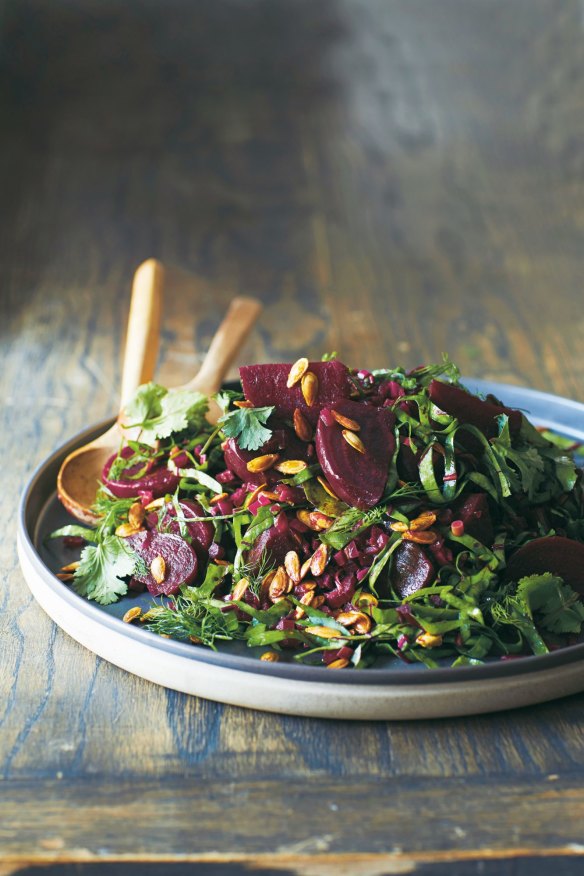
INGREDIENTS
- 1 bunch whole beetroot
- 2-3 tbsp olive oil, plus extra for drizzling
- salt
- 2 tbsp red wine vinegar
- 1-2 tbsp grated horseradish (depending on how much bite you like)
- 2-3 tbsp beetroot stem salsa (see recipe)
- handful beetroot leaves, thinly sliced
- handful chopped soft herbs, to serve
- spicy pepitas (see recipe below), to serve
- freshly cracked black pepper
METHOD
- Preheat the oven to 160C fan-forced (180C conventional) .
- Remove the beetroot leaves from their stems, then wash well and dry. Use the small tender leaves whole, and thinly slice the medium-sized leaves. (Any big tough leaves can be turned into chips.) Separate the stems from the roots, wash the stems well and then allow to dry and use them to make the beetroot stem salsa.
- Place the whole beetroot in a baking dish so they fit snugly. Add a few tablespoons of water and tightly cover with foil. Bake for about 1 hour, until the beetroot are soft enough to pierce with a knife but not mushy. Remove from the oven and allow to cool for 15 minutes. (If you're pressed for time, peel the beetroot, then cut into wedges, drizzle with olive oil and sprinkle with salt. Roast in a preheated 180C fan-forced (200C conventional) oven for 20 minutes or until tender. They often lose some of their juices with this method but they're still very tasty and it saves a lot of cooking time.
- Once cool enough to handle, the beetroot skins should easily slip off using your hands. Cut the beetroot into wedges and place in a large bowl. Add the olive oil, red wine vinegar, horseradish, beetroot stem salsa and ¼ teaspoon salt, then gently fold through the beetroot leaves.
- Tip the salad into a shallow serving bowl, top with the herbs, pepitas and plenty of black pepper, and serve.
Serves 4-6 as a side
BEETROOT STEM SALSA
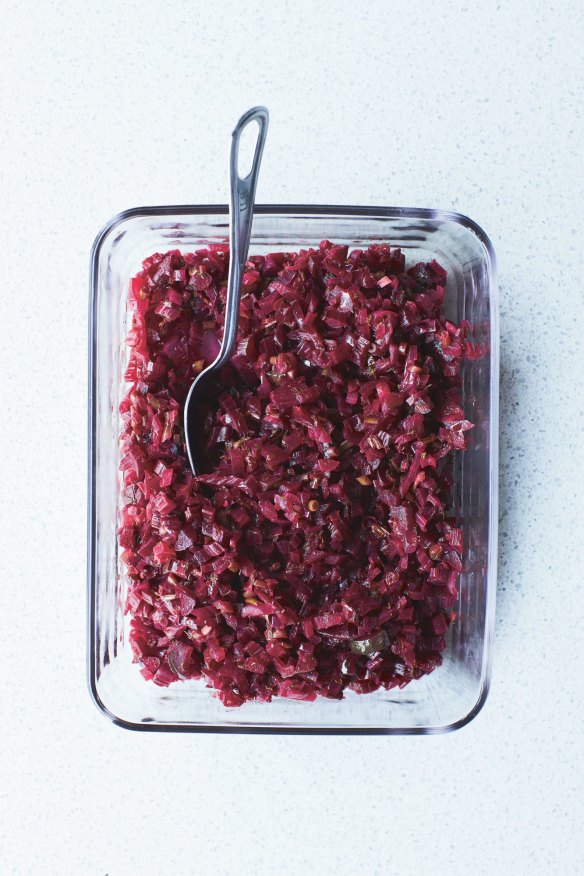
Enjoy this salsa on toast with eggs or goat's cheese, tossed through a beetroot salad or serve with grilled lamb.
Heat 2 tablespoons olive oil in a frying pan over low heat, add 1 finely chopped red onion, 210g (2 cups) thinly sliced beetroot stems, a handful of chopped dill leaves and stems and a pinch of chilli flakes and saute for 10 minutes. Add something salty, such as 1 tablespoon capers or finely diced dill pickles, chopped olives or preserved lemon, then add a little extra salt, a splash of vinegar and more dill. Cook for 5 minutes or until soft and sweet.
Makes about 2 cups
SPICY PEPITAS
Don't throw away your pumpkin seeds (pepitas)! This recipe shows you how to make your own spicy toasted pepitas. You can also make this with store-bought pepitas (just skip the first oven-drying step).
Scoop the seeds out of your pumpkin and remove the attached stringy flesh. Rinse the pepitas in a strainer, then place in a bowl of water. Pick out any pumpkin goop and strain again. Preheat the oven to 80C-100C fan-forced (100-120C conventional), spread the pepitas on a baking tray and place in the oven to dry for 15 minutes.
Remove from the oven and drizzle over a little oil of your choice, 1 teaspoon salt, 1 teaspoon paprika, 1 teaspoon ground cumin and a pinch of cayenne pepper, and stir to combine. Increase the oven temperature to 140C fan-forced (160C conventional) and bake the pepitas for a further 15 minutes or until golden. Set aside to cool, then store in an airtight container in the pantry for up to 2 weeks. Sprinkle over soups, salads or risottos.
Images and text from Use It All by Alex Elliott-Howery and Jaimee Edwards, photography by Cath Muscat. Murdoch Books RRP $39.99. Buy now